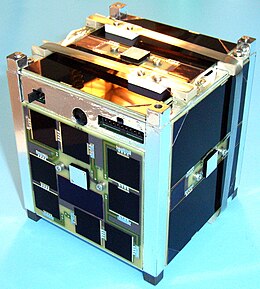 BeeSat-1 before launch BeeSat-1 before launch | |
| Mission type | Technology |
|---|---|
| Operator | Technische Universität Berlin |
| COSPAR ID | 2009-051C |
| SATCAT no. | 35933 |
| Website | www |
| Mission duration | 12 months (planned) 15+ months (achieved) |
| Spacecraft properties | |
| Spacecraft type | 1U CubeSat |
| Launch mass | 1 kilogram (2.2 lb) |
| Start of mission | |
| Launch date | 23 September 2009, 06:21 (2009-09-23UTC06:21Z) UTC |
| Rocket | PSLV-CA C14 |
| Launch site | Satish Dhawan FLP |
| Contractor | ISRO |
| Orbital parameters | |
| Reference system | Geocentric |
| Regime | Sun-synchronous |
| Perigee altitude | 713 kilometres (443 mi) |
| Apogee altitude | 723 kilometres (449 mi) |
| Inclination | 98.36 degrees |
| Period | 99.01 minutes |
| Epoch | 21 January 2014, 05:49:02 UTC |
BeeSat-1 or Berlin Experimental and Educational Satellite 1, is a German satellite operated by Technische Universität Berlin. The spacecraft is a single unit CubeSat, which was designed to test systems intended for use on future spacecraft, including a new design of reaction wheel. It has also been used for amateur radio, and is equipped with a small camera.
BeeSat-1 was launched by a Polar Satellite Launch Vehicle, serial number C14, flying in the Core Alone, or PSLV-CA, configuration. The launch took place from the First Launch Pad at the Satish Dhawan Space Centre, at 06:21 UTC on 23 September 2009. BeeSat-1 was a secondary payload aboard the rocket, which deployed the Oceansat-2 satellite. Five other secondary payloads were flown aboard the rocket; SwissCube-1, UWE-2, ITU-pSat1, Rubin 9.1 and Rubin 9.2.
BeeSat-1 is operating in a Sun-synchronous orbit with an apogee of 723 kilometres (449 mi), a perigee of 714 kilometres (444 mi) and 98.4 degrees of inclination to the equator. It has an orbital period of 99.16 minutes. BeeSat-1 was designed to operate for at least twelve months, and as of January 2011 it is still operational.
In 2024, PistonMiner repaired a number of software issues on the BeeSat-1, restored the telemetry function, and downloaded images from the camera for the first time. Their work was presented at the 38th Chaos Communication Congress in Hamburg.
See also
References
- "BEESAT Satellite details 2009-051C NORAD 35933". N2YO. 21 January 2014. Retrieved 21 January 2014.
- ^ "BEESAT-1". TUB. 25 May 2010. Archived from the original on 18 February 2011. Retrieved 6 January 2011.
- "BeeSat-1 (Berlin Experimental Educational Satellite-1)". eoPortal Directory. eoPortal. Archived from the original on 26 July 2011. Retrieved 6 January 2011.
- ^ "BEESAT". AMSAT. Archived from the original on 3 March 2011. Retrieved 6 January 2011.
- Wade, Mark. "PSLV CA". Encyclopedia Astronautica. Archived from the original on 11 October 2011. Retrieved 6 January 2011.
- McDowell, Jonathan. "Launch Log". Jonathan's Space Page. Retrieved 6 January 2011.
- Krebs, Gunter. "BeeSat". Gunter's Space Page. Retrieved 6 January 2011.
- Krebs, Gunter. "Rubin 9". Gunter's Space Page. Retrieved 6 January 2011.
- McDowell, Jonathan. "Satellite Catalog". Jonathan's Space Page. Retrieved 6 January 2011.
- PistonMiner (2024-12-30). Hacking yourself a satellite - recovering BEESAT-1. Retrieved 2024-12-31 – via media.ccc.de.
- online, heise (2024-12-29). "38C3: Hacker hijacks and repairs Beesat-1 satellites from the ground". heise online. Retrieved 2024-12-31.
| ← 2008Orbital launches in 20092010 → | |
|---|---|
| January | |
| February | |
| March | |
| April | |
| May | |
| June | |
| July | |
| August | |
| September | |
| October | |
| November | |
| December | |
| Launches are separated by dots ( • ), payloads by commas ( , ), multiple names for the same satellite by slashes ( / ). Crewed flights are underlined. Launch failures are marked with the † sign. Payloads deployed from other spacecraft are (enclosed in parentheses). | |
This article about one or more spacecraft of Germany is a stub. You can help Misplaced Pages by expanding it. |